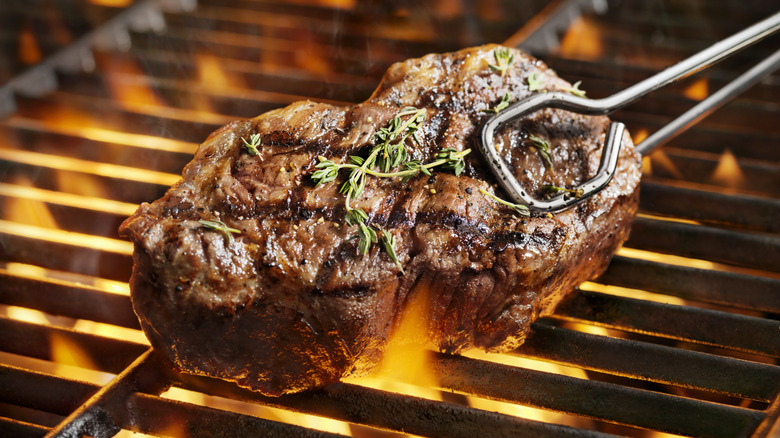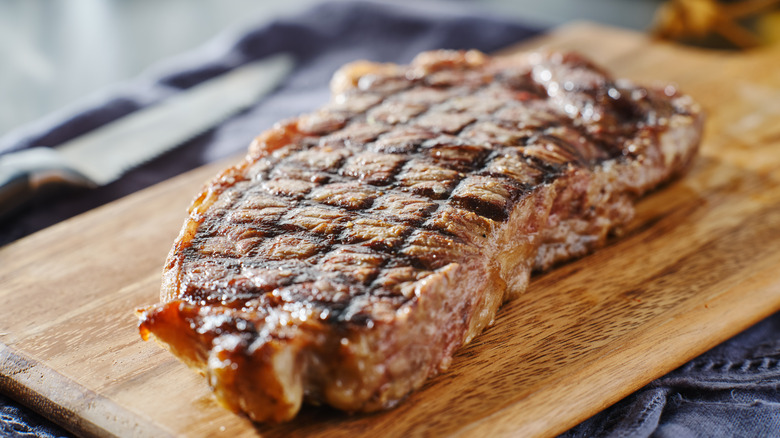How Bobby Flay Cooks A Juicy Steak Every Time
When you take a steak out of the pan or off the grill, the anticipation is high. You want it to have a beautifully charred, well-seasoned crust, with a succulent inside that makes that first beefy bite simply unbeatable. If you cut into it and it's overcooked, dry, or tough, it can be a frustrating disappointment. But you can't see inside the steak until it's cooked and sliced, by which time it's too late, so how do you know it's going to turn out juicy? Luckily, chef Bobby Flay has some tips to guarantee a great result every time. As he says, a whole lot of the success boils down to paying attention to temperature, in terms of both the cooking heat and the temperature of the steak itself.
Once you've chosen the best cut of steak for your cooking method, there are some fundamental basics regarding temperature; namely, get the steak to room temperature before you begin, and make sure the pan is already hot. How hot? Smoking hot, according to Flay; you want to actually see wisps of smoke if you want a good sear, so preheat the skillet for a few minutes. Once you start cooking, the aim is to make sure the steak isn't overdone, so that it remains juicy rather than drying out. For this part, Flay's temperature tip involves going lower than you might think.
Bobby Flay takes steak off the heat early
While there are several hacks to tell when steak is perfectly cooked, the best technique involves being precise and measuring it with a meat thermometer. The USDA recommends cooking beef to a minimum internal temperature of 145 degrees Fahrenheit, which is medium-well in steak terms. But if you're looking for medium-rare, the temperature range is more like around 130 to 135 degrees Fahrenheit.
However, that's not necessarily the number you want the thermometer to highlight when you physically remove the meat from the heat. As Bobby Flay explained on "The Rachael Ray Show," as seen on YouTube, you can always carry on cooking something that is underdone, but you can't reduce its 'doneness' once it's overcooked. And the thing with steak is, it continues to cook and its temperature keeps rising even when you take it off the stove or grill thanks to the residual heat.
The best way to ensure your steak doesn't overcook or become dry thanks to this "carryover cooking" as Flay describes it is to let the beef rest before it reaches the temperature you're aiming for; roughly 5 degrees Fahrenheit less is a good ballpark figure to keep in mind. So if you want the steak cooked to 140 degrees Fahrenheit, take it off when it reaches around 132 to 135 degrees Fahrenheit, Flay advises. It will continue to cook as it rests, reaching the desired temperature in the process.
Rest steaks properly for a guaranteed juicy result
Not allowing meat to rest is one of the key mistakes to avoid when cooking steak. But resting is about more than just letting the steak carry on cooking to your chosen shade of pink; it's about ensuring the meat becomes as juicy as possible once served. So, as tempting as it may be to dive straight into a hot sizzling steak straight off the grill, for chefs such as Bobby Flay, it's important to resist that urge.
A non-rested steak will leak juices all over your cutting board when you slice into it, whereas you want the juices to remain intact. And once again, temperature plays a vital role. While the temperature in the middle of a steak will stay high when meat rests for five minutes, the outside will begin to cool, and the fibers relax. As these fibers stretch open, liquid is pulled from the center towards the edges, meaning less comes out when you cut into it. But, rest the meat for five minutes more, and the center starts to cool and widen, too. The result is that the juices within are distributed more evenly.
In terms of how long meat needs to rest, it depends on the thickness of the steak, but the best guidance is to rest it for half as long as you cooked it for. Monitor temperature and timing, and you're guaranteed a succulent steak worthy of a pro.



